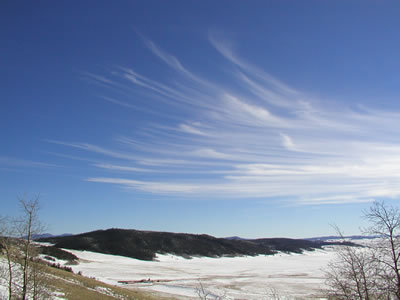A side view of a warm front (A) and how it is represented on a weather map (B)
Click on image for full size
Windows to the Universe image by Lisa Gardiner
Warm Fronts
A warm front is where warm air is pushing into colder air. Warm fronts move more slowly than cold fronts. It is harder for the warm air to move against the cold, dense air.
When a warm front passes through, you will often see high clouds like cirrus, cirrostratus, and middle clouds like altostratus before the front passes. These clouds form in the warm air that is high above the cool air. The clouds become lower and rain is likely at the front. There can be thunderstorms around the warm front sometimes too.
On weather maps, a warm front is shown with a solid red line with red, filled-in half circles along it, like in the map on the left (B). The half circles are on the side of the line where the front is moving. Notice on the map that temperatures are cooler in front of the front than behind it.
Last modified August 12, 2009 by Lisa Gardiner.
You might also be interested in:

Cirrus clouds are the most common of the High Cloud group. They are made of ice crystals and have long, thin, wispy streamers. Cirrus clouds are usually white and predict fair weather.
...more
Cirrostratus clouds belong to the High Cloud group. They are sheetlike thin clouds that usually cover the entire sky. The sun or moon can shine through cirrostratus clouds. When looking at the sun through
...more
Altostratus clouds belong to the Middle Cloud group. An altostratus cloud usually covers the whole sky. The cloud looks gray or blue-gray. The sun or moon may shine through an altostratus cloud, but will
...more
Raindrops form when tiny water droplets collide together in clouds to form bigger ones. When they get too heavy, rain falls out of the clouds. Rain is more than 5mm in diameter. The types of clouds that
...more
Thunderstorms are one of the most exciting and dangerous types of weather. Over 40,000 thunderstorms happen around the world each day. Thunderstorms form when very warm, moist air rises into cold air.
...more
Weather fronts can cause clouds, rain, thunderstorms, gusty winds, and even tornadoes. Usually the skies clear once the front has passed. Weather fronts happen because not all air is the same. In some
...more
Weather fronts can cause clouds to form. Fronts happen when two large masses of air collide into each other at the Earth's surface. Warm fronts produce clouds when warm air replaces cold air by sliding
...more















